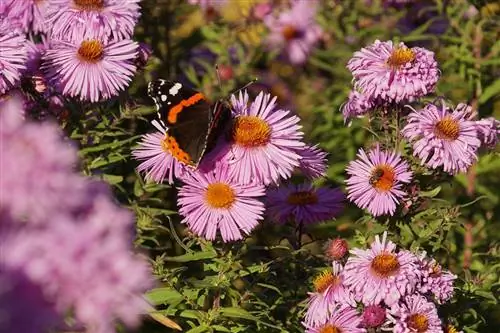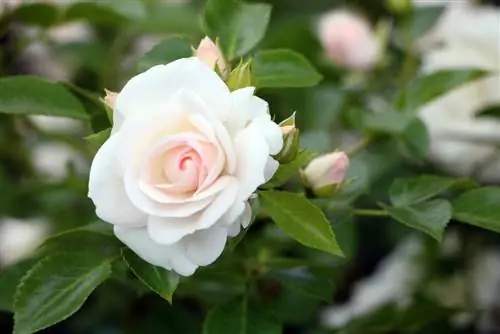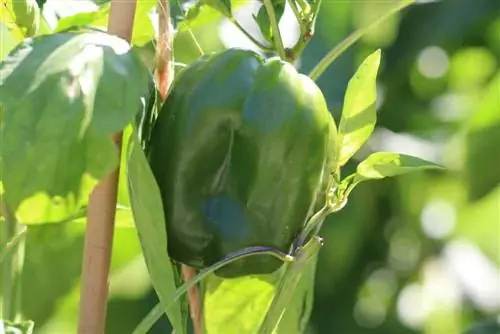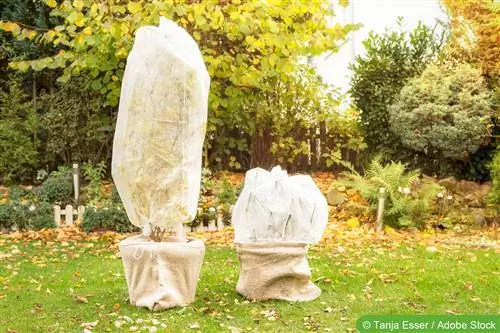- Author admin [email protected].
- Public 2023-12-17 03:39.
- Last modified 2025-01-24 12:45.
With its striped leaves, the Aloe variegata looks exotic and wild. Because the pattern is reminiscent of tigers, this South African succulent is also called tiger aloe. As exotic as she is, her demands are small and she even forgets mistakes in care from time to time.
No time to water and you occasionally forget to fertilize? The tiger aloe doesn't take offense too quickly.
This makes it the ideal plant for anyone who wants to put in little effort but still doesn't want to miss out on decorative greenery. As low as the requirements of the South African tiger aloe are, it also needs the right location and the right conditions in order to thrive and even bloom for a long time.
Location
The tiger aloe comes from South Africa and grows here primarily in dry and hot areas. As a succulent, it is ideally adapted to this. Even if it is grown in a pot, these requirements must be met. The location of the Aloe variegata should be sunny or at least partially shaded, warm and not too humid. However, even significant temperature fluctuations have little effect on the tiger aloe. So she can stand on the window sill above the radiator.
Substrate
The choice of substrate is also uncomplicated for tiger aloe. Aloe variegata thrives optimally in cactus soil or a loose substrate to which additional sand is added. In any case, it is important that the soil you choose is loose and permeable. It should not tend to compact and allow water to drain away easily.
Pouring

The tiger aloe is not a big drinker. It is undemanding even in dry locations and at high temperatures. Watering can and should therefore be kept small and spaced far enough apart so that at least the upper layers of the substrate can dry out. If the Aloe variegata needs water, it shows this very clearly by its leaves. These appear saggy, show wrinkles and lose firmness.
Only when this occurs is it absolutely necessary to water the tiger aloe. It can happen before that, but it can still wait.
In addition, pay attention to the dryness of the leaves when watering. If too much moisture gets caught in the leaf axils, it can lead to the death of the leaves and even entire parts of the plant. Watering from above is therefore extremely inconvenient or must be done with great caution. It is better to water the tiger aloe from below or place it in a bowl of water for half an hour. The substrate can soak up on its own and there is no danger to the leaves.
Tip:
In order to stimulate flowering, Aloe variegata needs the stimulus of a dry phase followed by a 'rainy season'. If you want to see the delicate beauty, you shouldn't overdo it with the water.
Fertilize
In the growth phase from April to September, the tiger aloe benefits from additional nutrients. These are ideally supplied in the form of special cactus fertilizer, which can be added to the irrigation water. Fertilizing every two to four weeks is usually sufficient. If a gift is forgotten, it is not dramatic. It should be noted, however, that the fertilizer is not added directly to the soil. This could cause damage to the leaves and roots.
Blend
A blend of tiger aloe is neither necessary nor advisable. However, if parts break off, the injured area can be smoothed cleanly. This measure ensures that the interface dries faster.
Repotting
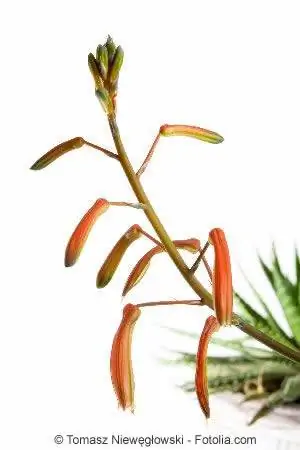
Repotting the tiger aloe for reasons of space is rarely necessary. Since it reaches a maximum height of 30 cm and grows comparatively slowly, repotting is mainly used to change the substrate. This should be done every two to four years. If changing the pot initially serves to increase the size, the container should only be chosen one or two sizes larger. This measure restricts the root system and ensures that the succulent grows faster above ground. Apart from this, there is nothing to consider when repotting the Aloe variegata.
Propagation
The easiest way to propagate Aloe variegata is to root offshoots. These are formed by the tiger aloe itself and can be found around the base of the plant. If they are five to seven centimeters tall, they can be carefully separated from the mother plant. In order to root them, the cut or broken areas should first be allowed to dry for a few hours. Only then are they placed in a mixture of potting soil and sand or cactus soil. If the substrate is slightly moist, the cuttings will develop roots comparatively quickly if they are kept bright and at around 20 °C to 25 °C.
Tip:
If you can get seeds from the tiger aloe, you can also propagate them using them.
Wintering
The tiger aloe can be kept at normal room temperatures even in winter. If it was left outside during the summer, it should be brought indoors in good time. The time to do this is when temperatures have dropped to 15°C to 18°C. Aloe variegata that is cultivated indoors remains in its original place. Fertilization can be stopped completely during the winter. However, occasional watering as soon as the leaves no longer appear plump is necessary.
Typical care errors, pests and diseases
As a rule, neither diseases nor pests occur on the tiger aloe. However, incorrect care can lead to diseases such as rot. Typically, the Aloe variegata is kept too moist, i.e. watered too often or too often. It can then wilt from bottom to top and show greasy spots. It is also possible that the watering is incorrect. If too much water collects in the armpits, it can also lead to rot or mold.
Frequently asked questions
Is tiger aloe poisonous?
The Aloe variegata is poisonous in all parts and is therefore only partially suitable for households with children and pets. It is also better not to have tiger aloe in areas such as passageways that are heavily trafficked and frequently used. The risk of parts breaking off and plant sap escaping is too high here.
Why isn't my Aloe variegata blooming?
The tiger aloe only blooms when it is a few years old. If no buds appear initially, there is no reason to worry. However, a lack of flowering can be due to deficiency symptoms or a location that is too dark. If the cultivation conditions are right in these areas, the flowering can be helped by a dry season.
What you should know about tiger aloe in brief
- The tiger aloe likes a location in full sun. If necessary, a partially shaded spot will do.
- It is important that the plant is protected. It shouldn't be able to rain on them.
- If water collects in the leaf shafts, it can lead to rot.
- The planting substrate should be permeable to water. Normal potting soil is mixed with coarse sand, gravel, expanded clay or similar.
- Aloe variegata requires very little water. It can tolerate dryness rather than too much moisture.
- Watering water is stored in the leaves and released when needed.
- During the growing season, fertilization is carried out every two to four weeks with a universal or cactus fertilizer.
Wintering
The tiger aloe is not frost-resistant outdoors and must be overwintered indoors. The temperatures should not fall below 5 °C. It is important that the plant substrate is very dry, otherwise the roots will rot quickly. The cooler the Aloe variegata is, the drier the substrate should be. The plant copes excellently with dry air. Overwintering in heated rooms is therefore ideal. If you water, do not over the leaves as this can also lead to rot. The plant must also not be sprayed. If necessary, repot in spring into a water-permeable substrate.
Propagation
Tiger aloe is propagated via cuttings or seeds. Offshoots are the side shoots that form around the plant. You can cut them off. The interface is then allowed to dry and the cuttings are placed in cactus soil or a water-permeable substrate. Watering is done very sparingly.


